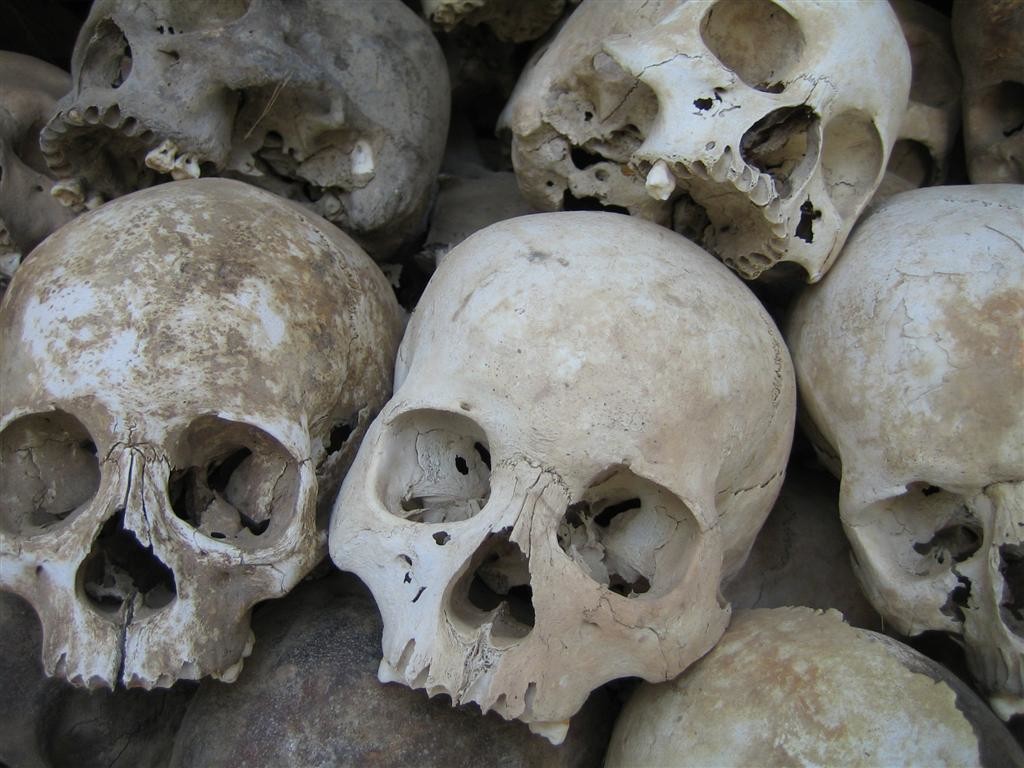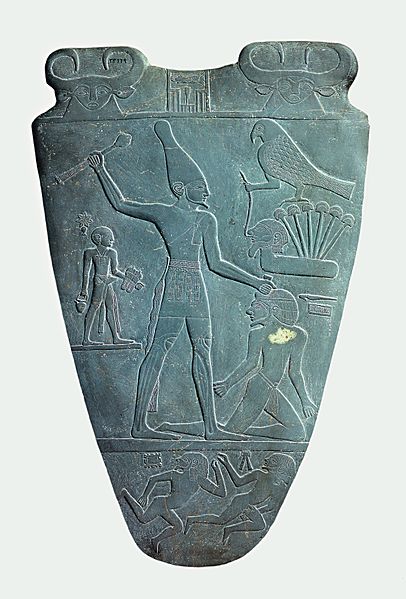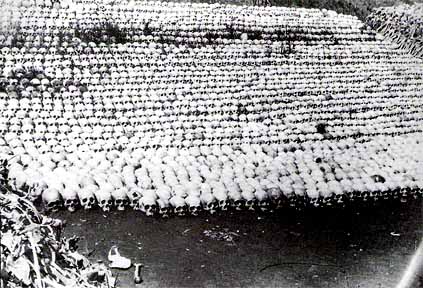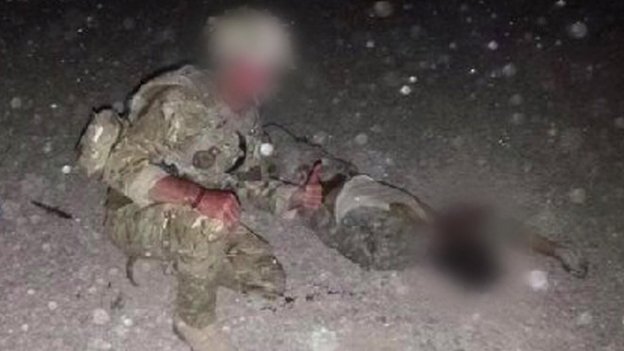Photographs of the Dead in War

Taking photos of the dead might be controversial, but it is all too human.
On May 9th, the BBC reported a story about the war in Afghanistan that was mostly overlooked by North Americans. The U.K. Ministry of Defence, it was revealed, was investigating two RAF service members for pictures of them posing with dead Taliban fighters after the September 2012 attack on Camp Bastion. BBC Defence correspondent Jonathon Beale wrote that “There can be few excuses for this type of behaviour”, and concluded his analysis stating that “This is another incident likely to spark very different emotions — offensive to many but perhaps even understandable to some.”
Contra Beale, incidents such as these are not hard to understand. They are, in fact, based on universally shared human traits, albeit ones that are offensive to many in the idealized and cosmopolitan “international community.” If we wish to understand this incident, and similar ones, we need to go back to these human universals.
Human Universals
The basic form of a human universal is something grounded in the biological reality, including the evolutionary psychology, of our species as a high order probability. Items or events such as birth and death, sensory systems such as eyesight, hearing or touch, survival systems such as the desire for mates and progeny and group formation are all human universals.
A second form of human universal emerges from the interaction of basic universals with the lived environment. For example, all cultures have kinship systems, which are based on mate selection and rule of thumb genetic considerations, but kinship systems can, and do, vary wildly. This second form of universal, being based in part on the social environment, is subject to change as the social environment changes, through the acceptance of new discoveries and/or via the social construction of new interpretations. So, what do human universals have to do with the taking of “gruesome” and “graphic” pictures? Quite a bit, actually.
The first point we need to consider is that the vast majority of human beings find it difficult to kill other human beings. With the extremely small exception of sociopaths (think Dexter), people have to learn how to kill other people in anything other than perceived self-defence. Indeed, this general reticence to kill other humans is a species survival trait, since a group composed primarily of sociopaths would end up killing itself off while a group incapable of self-defence would be killed off by other groups or species.
Killing in perceived self-defence produces a very interesting physiological response. While it is frequently talked about in terms of the “fight or flight” instinct, what it actually refers to is the activation of the sympathetic nervous system and flooding the body and brain with adrenaline and noradrenaline. The main physiological effects are to heighten strength, slow perceived time, increase and focus visual acuity, and heighten pain thresholds. The experience is often described as being “fully alive,” “being wired,” and in some cases, being “in the zone.”
There are, however, certain functional problems with relying on the spontaneous activation of the sympathetic nervous system. For one thing, people who are untrained in its effects focus in on immediate threats only. While this may work to protect a small group from an attacking lion, it doesn’t work well against a coordinated attack against the group by multiple threats. For another thing, constantly activating the sympathetic nervous system takes a heavy toll on the human body. Put simply, you can burn yourself out very easily and damage your body and mind (check out the cumulative effects of stress). No group that needs people who can kill can afford to rely on this self-defence mechanism.
Which brings us back to learning how to kill other people without relying on the spontaneous activation of the sympathetic nervous system. Or, in other words, learning how to kill without succumbing to the neurophysiological and psychological effects inherent in the activation of the sympathetic nervous system. Learning, however, is a social activity and the learning systems that allow for groups to have continuous access to people who can kill are also social. These learning systems, while universal, are second-order human universals, on the same order as kinship systems and, historically at least, equally diverse.
Learning to Kill
In general, all of these learning systems share four primary functional areas:
- Interpretation
- Justification
- Physical (training)
- Psychological coping
Let me start with the second area, justification, since it underlies, in part, the interpretation. The vast majority of justification systems boil down to one of three messages. First, the target group is not human (or not fully human, i.e., they are not a person). Second, the target group has lost their humanity by their actions. Third, the target group has attacked us.
The first and second of these underlying justifications boil down to one simple message: you can kill them without guilt since they are not (currently) fully human. Obviously, the first justification is easiest if there are clearly observable differences between the two groups, but differences in custom, language, belief, or practice will serve as well as any physical differences. The third justification is self-defence, although this can be a remarkably fluid category.
The area of interpretation is, as I noted, dependent in part on the justification. For example, a justification based on “not human” requires a systematic symbolic dehumanization of a target group over a relatively long period of time. Historical examples include those based on observable physical differences (e.g., skin or hair color), language, and religion (amongst others). This form of justification, however, makes interpretation simple: The target group may be killed whenever a need or desire is felt.
Justifications based on the temporary loss of human status are trickier since they require that the initial group have a solid definition of a) what will cause a group to lose that status and b) what can be done to gain it back again. They are used when the initial group’s symbology accepts the target group as inherently human and, most often, when the two groups have a shared history of interaction beyond fighting, such as trade, intermarriage, shared religion, language, etc.
Justifications based on self-defence should be, but are not always, obvious. For example, a self-defence justification may be obvious in the case of a physical invasion, but may also be employed in cases of cultural or symbolic invasions or even in the case of pre-emptive self-defence.
Needless to say, one usually finds a blending of all three of these justifications, and the tricky part lies in the interpretation. Is this action an attack? Can it be construed as such? Does an action or choice make a group not human? The obviousness of an interpretation often gives way to the desirability of an interpretation in purely pragmatic terms and the ability of factions within a group to sell that interpretation to the rest of the group.
Psychological coping mechanisms emerge and evolve within two broad sets of boundary conditions: those based on neuropsychology/neurophysiology and those based on the cultural justification systems. The interaction between these two broad sets of boundary conditions is often problematic for the individuals involved since the justification systems are embedded in larger symbol systems — often religious in the Geertzian sense — while neuropsychological and neurophysiological boundary conditions are embedded in the lived reality of the individuals. In effect, the first set deals with what the group defines as “what should be,” while the second defines, for the individuals involved, “what is.” Psychological coping mechanisms then are both evolved (i.e., part of the traditions and practices of the group) and, at the same time, emergent sense-making activities on the part of individuals.
In some cultures, these psychological coping mechanisms have had centuries to evolve and are often quite stable in relation to the broader cultural justification systems. Historically, these broader cultural justification systems have been lodged within religious systems, and the metaphysical assumptions of these systems often continue to influence justifications even after the overtly religious component has been removed. This is certainly the case in 2014, where the Christian theology and metaphysics of St. Augustine continue to influence our conceptions of the conduct of warfare and have been enshrined in both International Conventions and International Law.
But if the theology and metaphysics of St. Augustine still underlie much of how the modern, Western world constructs justification systems and views the practice of warfare, they no longer shape and form the general practice of psychological coping mechanisms, having lost that social monopoly after World War I. In many ways, the responsibility for producing psychological coping mechanisms — what Foucault refers to as “technologies of the self” — has been abstracted from the religious bases that contained, constrained, and gave them ultimate meaning in the first place.
Perhaps more importantly, the lack of a constant, culture-wide, transcendent view of reality (both physical and metaphysical) encourages the development of psychological coping mechanisms for those who kill at the behest of society that are radically different from, and often offensive to, those who do not. Or, in plain English, it enhances the civilian-military divide, shocking the civilians while annoying the military.
This effect of this shock on civilians has been one of the impetuses behind certain forms of art for at least the past 5,000 years. In its simplest form, the message is often simple: “submit or die.” But, while the message is simple, the context is not. Furthermore, the actual context stretches well beyond combat.
One of the effects of activating the sympathetic nervous system — whether this is in combat, playing a sports game, or performing a Bach mass — is a heightened awareness of the immediate in order to meet a challenge. But all challenges end, and individuals must come down from their adrenaline highs. If the challenge has been met — victory in combat or sports, a successful performance, getting to the bottom of a ski hill alive — then the individual has to deal with that high, which is often done by recounting the event with supporters in a social setting.
Second, the recounting of the challenge, which is both a sense-making and storytelling event, recasts the memories of the group into a more coherent form and brings that story into alignment with the broader social and metaphysical assumptions of the group. At the same time, the stories constructed as a result of the challenge influence the broader social justification for the challenge.
Those who have not been following the Art of War blog may be wondering how all of this ties in with pictures. The answer is simple: pictures are frozen stories.
Let us consider one of the earliest (~3000bce) shock pictures: the Narmer Palette (see Image 1). Narmer, or as he is sometimes called, Menes, unified Upper and Lower Egypt. This side of the palette, the “Smiting Side,” clearly shows Narmer holding a mace, readying a strike on a captive, while the god Horus (the Hawk) supports him. Underneath, we see two bodies.

While there is some disagreement over the meaning of the Palette, the overall message is clear: submit or die. Furthermore, the submission is not solely to Narmer; it is also to the divine order represented by Horus. The side band message is clear: full humanity is defined by submission to both the secular and divine order.
The Narmer Palette is an example of a justification system where the target group has lost its humanity, temporarily, by their actions. The conquest shown in the Palette is the result of the target group choosing (according to the main group) to not follow right action, and harmony, both divine and secular, is restored by the conquest. Or, for those who prefer a less religious and more secular, progressive description, one might recast the Narmer Palette as Regime Change for their own Good.
Taken to its logical extreme, the non-acceptance of right action leads, inevitably, to the dehumanizing of those who refuse to agree, and this has also found its way into pictorial representations. While the immediate example that springs to mind currently would be the Nazis, a better example is actually the Khmer Rouge, a group that took the progressive ideology (religion) of Communism and class conflict to its natural, and logical, conclusion.
In the 1970s, the Khmer Rouge effectively gained control of Cambodia and proceeded to implement their version of agrarian reform, moving large numbers of “capitalist oppressors” out of the cities and into “productive” work. This mass population relocation — involving upwards of 50% of the population of Cambodia — led, inevitably, to mass deaths. These deaths, currently estimated in the range of 1.7 million, or more than 30 percent of the total population, were defined both as necessary and as justifiable in order for the revolution to succeed.
Part of the application of Taylor-esque, industrial production techniques to the elimination of humans by the Khmer Rouge, involved a problem that the Nazis were well aware of: How do you deal with the bodies? Unlike the Nazis, who used an almost hidden form of elimination, the Khmer Rouge gloried in its exterminations and used monumental visual imagery (see Image 2): a form of “war amongst the people” that I doubt Mao had foreseen.

This process of dehumanization is, I would suggest, an inevitable outcome of the interplay between operating within a justification system and a continuing competition. For example, short, quick wars tend not to produce a vicious level of animosity between the protagonists. Longer conflicts, however, do tend to produce an increasing level of dehumanization, especially when the conflict is “transcendental” (i.e., competing religions in the Geertzian, vice Huntington, sense), and this is shown in the pictorial record.
One interesting, and rarely discussed, example of this process comes from the Vietnam War. Unfortunately, I do not have a copy of the specific picture involved, but I do have a news report, written by Jack Anderson, entitled “Deathly Christmas” from 1969.
The Army, while professing to abhor the mentality of My-lai, has just pinned a brigadier general’s star on George Patton III who mailed out grisly Christmas cards of dead Viet Cong from Vietnam last year.
Under a ‘Peace on Earth’ inscription, Patton glued color photos of stacked Viet Cong bodies. He also posed, grinning, with the polished skull of a guerrilla with a bullet hole above the left eye. The skull was a going-away present from his men.
The bodies that decorated Patton’s Christmas card had been killed by his 11th Armored Cavalry Regiment, a gung-ho outfit that averaged 8 or 10 firefights with the enemy each week.
He impressed upon his men that war was a kill-or-be-killed business, and he told superiors who inquired about his grotesque Christmas card that he merely wanted to illustrate ‘the irony of war.’
Now, the trope of “Peace on Earth” followed by pictures of dead opponents is actually quite old and recalls the Narmer Palette with its re-establishment of harmony in Heaven and Earth. The current version of this trope is, I would suggest, “Peace Through Superior Firepower,” a trope gorgeously illustrated recently in this image (Image 3), but supported philosophically by the Melian Dialogue.

The Melian Dialogue, and the current Peace Through Superior Firepower trope, encapsulate an evolutionary reality: those best fit for the environment survive. And, furthermore, both of these suggest an interesting observation: one’s opponents in a contest must be perceived as human and equals if they are to be treated as human in a conflict situation.
So, let us return to the start: the pictures of RAF servicemen posing with the bodies of the Taliban insurgents who attacked Camp Bastion in 2012.
The justification for the war in Afghanistan was based on self-defence, and one of the corollaries of a self-defence justification is that, barring extreme actions, your enemy is human. I will also note that the humanity of Afghans, whether Taliban or not, has never been seriously challenged, and has been a central assumption of the counterinsurgency campaign. In effect, the entire social system operating for the RAF servicemen has placed the Taliban as human and equal competitors.
But what, exactly, do these pictures show? While the publicly available pictures are purposefully blurred, they appear to show an RAF service member giving the thumbs up sign with the dead body of a Taliban fighter (See Image 4). Far from being gruesome and grotesque, what we see, I would suggest, is an expression of honouring an opponent.

I can, in my mind, hear the outraged voices of people who have never had to fight and kill, or deal with violence, yelling at me as I write that phrase. But, before I am drummed out of membership in the international community of the caring and sensitive, or disinvited from giving a commencement address, let me ask those who are offended one simple question: have you ever felt the joy of being alive and surviving something where you could have died? If the answer to that is “No,” then I would, with all due respect, suggest that you withhold your indignation, and I would echo Oliver Cromwell in his letter to the Presbyters of Scotland: “Brethren, I beseech ye in the bowels of Christ to consider that ye may be mistaken.”
Marc Tyrrell is an anthropologist teaching at the Institute of Interdisciplinary Studies at Carleton University (Ottawa, Canada). He is a Senior Research Fellow with the Canadian Centre of Intelligence and Security Studies.
Photo credit: Joel Burslem

